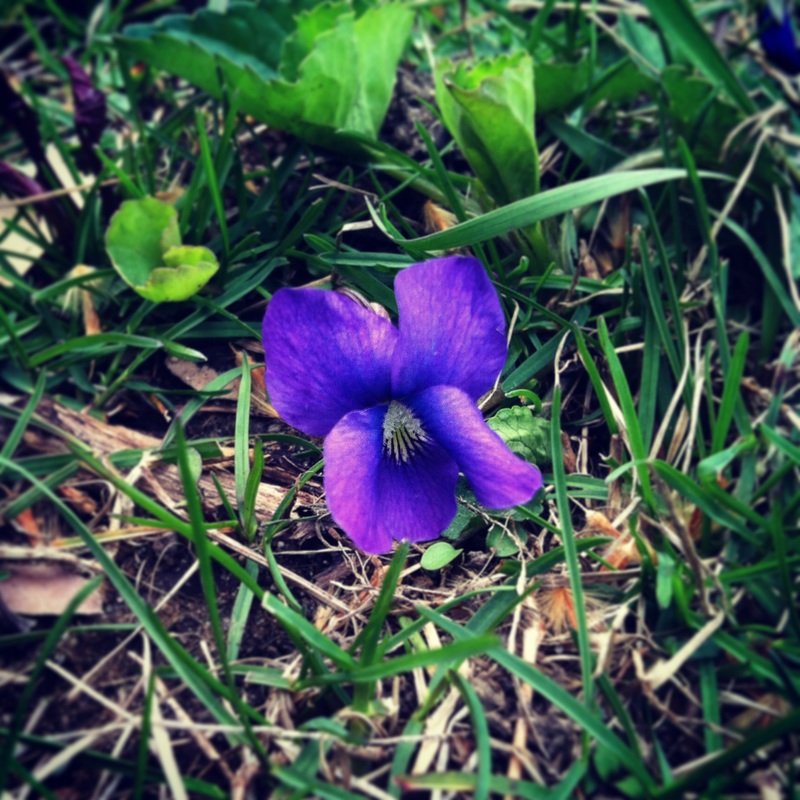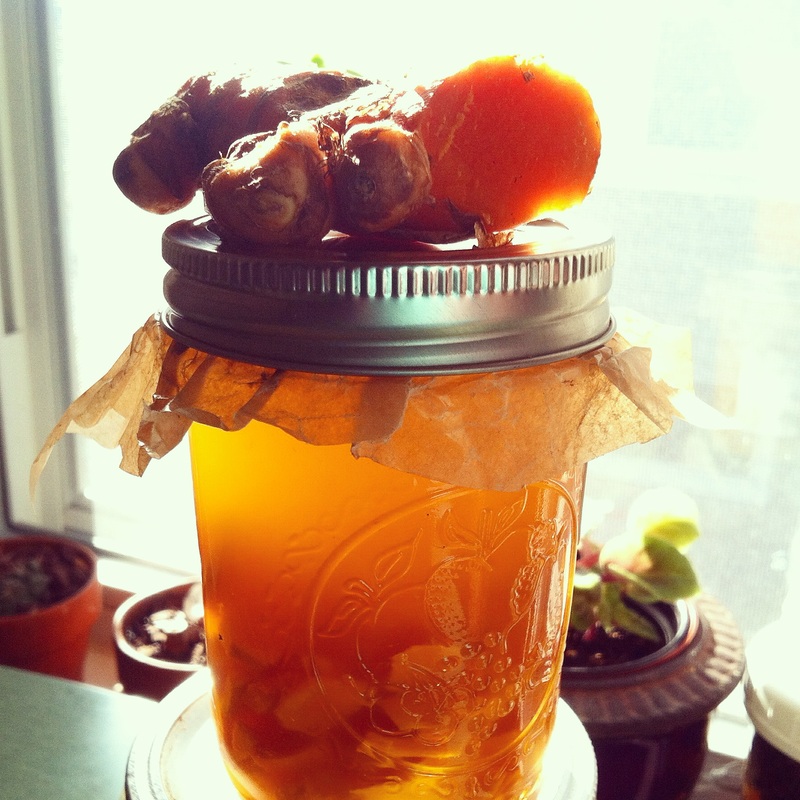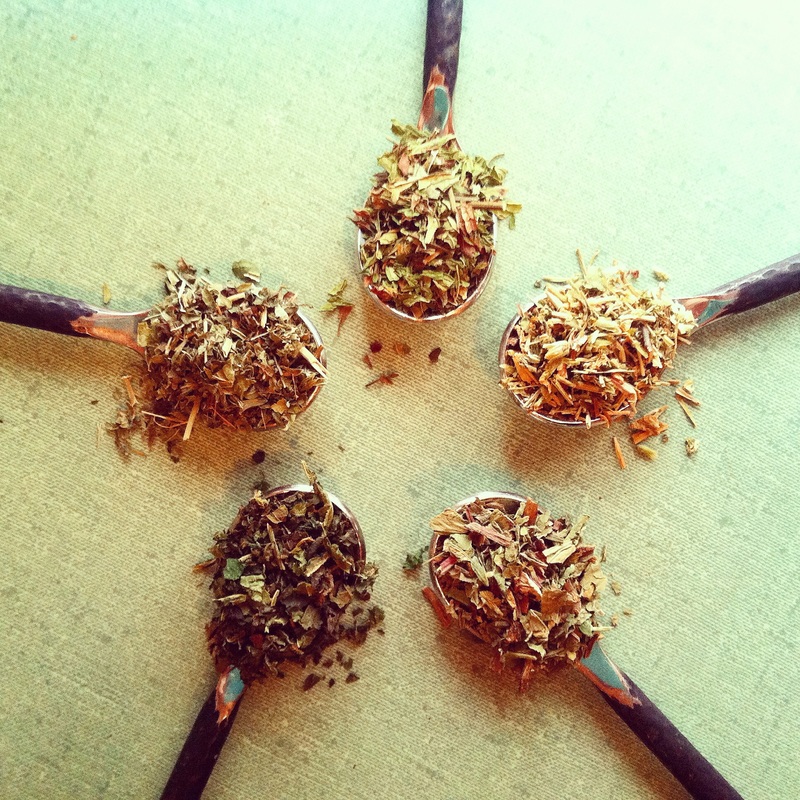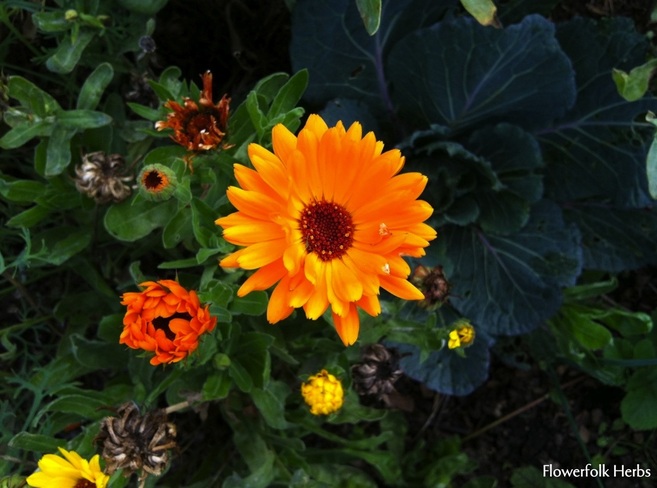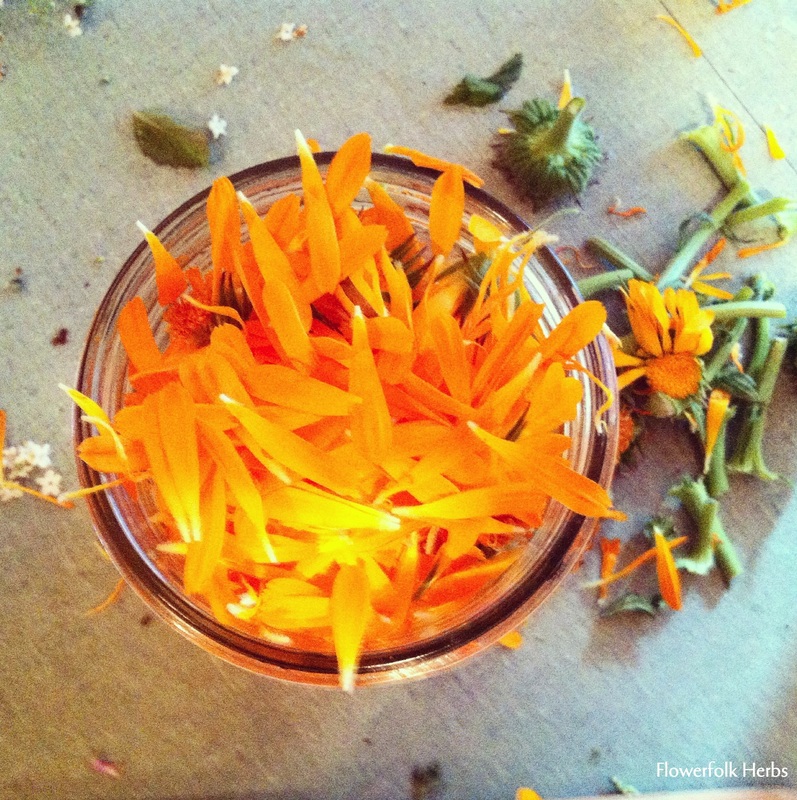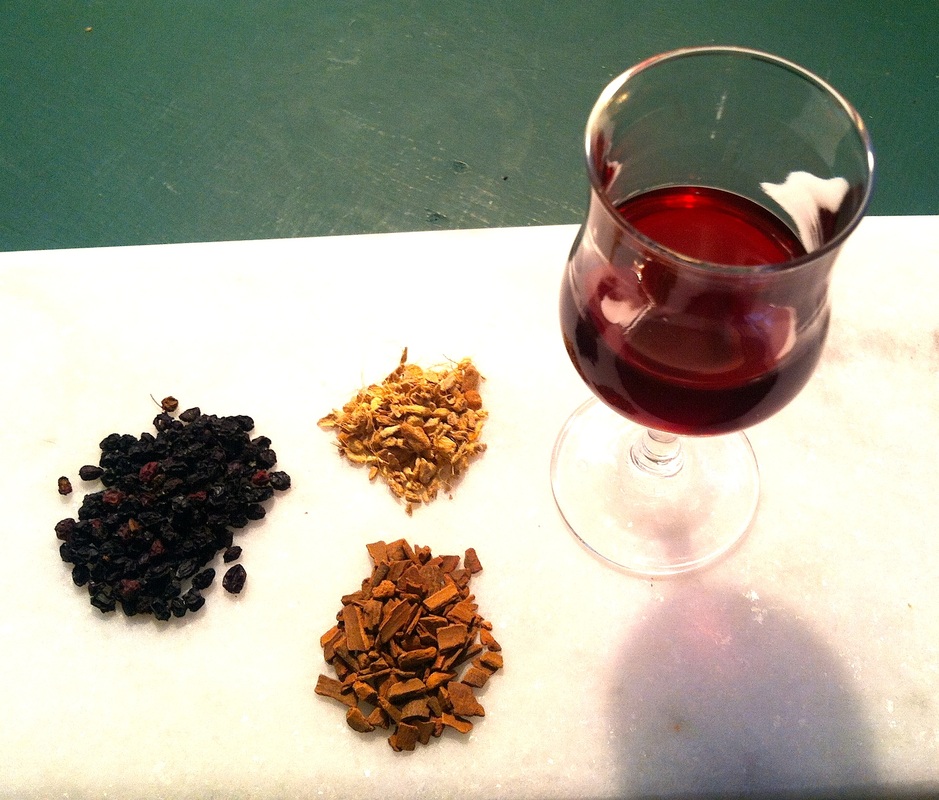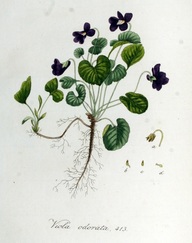 Today the wild violets in my backyard are blooming for the first time this season. They have been gently growing these past few weeks, unfurling their leaves, but today - like magic - they revealed their purple faces to the world. I could not think of a better plant to symbolize spring’s feeling of renewal than the sweet violet flower. With its tender, young, heart-shaped leaves, and its brilliantly colored flowers, it is truly a balm to a winter-weary spirit. As the violets bravely emerge in the still chilly temperatures, I think of them as sweet love letters unfolding from the earth. One of our best and most nutritious wild spring edibles, violet leaves and flowers are high in Vitamins A & C. You can eat them raw, plucked right from the garden; I like to add them to fresh salads for a beautiful spring touch. Violet has a slight mucilaginous quality to it, which means it contains a type of polysaccharide that imparts a viscous quality to water when extracted – a quality that is extremely soothing and cooling to mucous membranes. As such, violets can help calm inflammatory conditions, whether it is itchy skin, inflammation in the gut, or a scratchy, sore throat. Use violets on any irritated tissue – they will provide a cooling and soothing relief. Or, as the famous English herbalist Culpepper said, “All the Violets are cold and moist, and are used to cool any heat or distemperature of the body, either inwardly or outwardly.” Violet is also known as a traditional “blood purifier” or alterative herb. This makes it a wonderful and gently detoxifying plant for the spring season, helping our bodies to wake up from the winter and move along any stagnation. Just as the sap in the trees starts to move, so must we move the inner fluids of our bodies, especially through the filter of our lymphatic system. Violet is one of our best lymphatic herbs and is often used to support the removal of toxins from the system. Herbalist Matthew Wood especially recommends violet for “lymphatic stagnation and swollen glands, often in the throat or around the ears.”
If you read old herbal texts from a few centuries ago you will discover that violet was also prescribed as a support for emotional upset – it was said to “comfort and strengthen the heart” and to “to moderate anger.” Violet has an amazing ability to bring its soothing comfort to any inflammatory situation, whether physical or emotional. Botanically speaking, the violet plant is quite unique. Violets actually produce two different kinds of flowers – first the spring-born flowers (which attract both bees and humans alike). Usually, however, these flowers do not produce seed. Later in the season, violets produce a second kind of flower that grows close to the earth, or underground. Called cleistogamous flowers, these hidden blooms do not usually fully open, and are self-pollinated. Try pulling away the leaves of a clump of violet in late summer or early fall to find these unusual, pale flowers. If you happen to find a seed pod, take a peek inside – you will be most amazed to find a capsule full of luminous, iridescent seeds that shimmer in the sunlight. The first time I discovered the hidden secret of the humble violet, it took my breath away with its beauty. HOW TO FORAGE AND USE: Violets are abundant in early spring, and may even spontaneously grow in your backyard or garden. As with harvesting any wild plant, be sure that you are collecting plants in an area that is free from contamination. It is always a good idea to test your soil for heavy metals, and to stay away from collecting near busy roadsides. Once you have determined a suitable place to harvest your violets, you can pluck the young leaves and flowers when they first emerge and eat them raw in fresh salads. Violets are in their prime when the weather is still cool, so take advantage of the flowers while they are available. Once the weather turns warm, only the leaves will remain. You can also use dried violet leaf and flower when the fresh plant is not available, but the vivid purple-blue color of the flower will fade once dried. To make a violet infusion, steep up to 1 Tblsp. dried leaf in 8 oz. hot water for at least 10-15 minutes. If you would like to extract more of the soothing, mucilaginous qualities mentioned above, steep the dried leaf in cold water instead, which will preserve the beneficial polysaccharides. Violet blends well with other herbs such as rose, oat tops and linden for a relaxing tea. Note: The Violet we speak of here (Viola odorata and related species) is NOT the same as the indoor houseplant, the African Violet, which is unrelated and poisonous. Be sure to only use plants you have positively identified. A Spring Recipe: VIOLET SYRUP adapted from herbalist Susan Weed Ingredients: 1/2 pound fresh violet flowers 2 cups water 2 cups raw honey Directions: Collect your violet blossoms. Boil the water and pour over the fresh blossoms; cover. Let steep overnight in nonmetallic container. The next day, strain out the flowers and reserve the bright purple liquid. Combine the violet infusion and honey in a saucepan. Simmer gently, stirring, for ten or fifteen minutes, until it seems like syrup. Fill clean jars. Cool. Keep well chilled to preserve. This article was originally published on Cambridge Natural's blog. I love using vividly-hued plants this time of year, when the winter has made us snow-weary, and we all long for more color in our lives.
Adding brightly colored herbs to tea infusions always adds a bit of cheer to the day. Think of cornflowers, hibiscus, rose and calendula - even when dried these petals retain their lovely colors... I concocted the following recipe -- a delicious & bright turmeric oxymel -- in the spirit of bringing more color into my life. If you haven't made one before, oxymels are simply a combination of vinegar & honey infused with herbs. Turmeric is a wonderful health tonic that benefits the whole body in many ways, and it is especially good for supporting healthy digestion and liver function. It is renowned for its anti-inflammatory properties and helps to protect and invigorate the liver. This is a delightful food/medicine for spring-time wellness! LIVER-LOVING TURMERIC OXYMEL: 4 Tblsp. powdered turmeric OR 3 Tblsp. fresh grated turmeric 1 Tblsp. crushed black peppercorn 1 Tblsp. crushed cardamom pods local honey apple cider vinegar pint-sized glass jar wax paper
While we are still blanketed in snow and temperatures are frigid, this month is full of hope and renewal. With the arrival of the equinox on March 20th comes the official start to spring and longer, warmer, and greener days ahead.
In celebration of the equinox I formulated the following blend. This tea is a simple way to get lots of easily-assimilated minerals into your body, while also supporting the liver and your body's pathways of detoxification. It feels like a gentle spring cleaning for your whole system! Don't be surprised if you feel lighter and more energized after drinking this infusion over the course of several days. Your eyes will sparkle and your liver will thank you! EQUINOX TEA 1 part Nettles 1 part Alfalfa 1/2 part Dandelion leaf 1/2 part Chickweed 1/4 part Spearmint (This recipe is proportional. 1 "part" equals any sized bowl or measurement of your choice so that you can make as large or as small a batch as you'd like.) Blend all herbs together. Place 5 heaping Tblsp. in a glass quart-sized jar, cover with boiled water and cap immediately. Let this steep overnight or for at least 7 hours at room temperature. In the morning, strain out the herbs. Gently re-heat the brew if you wish, or drink it as is. Store any extra tea in the fridge and drink within two days. Happy soon-to-be Spring! Calendula is a quintessential summertime herb – its flowering reaches its peak during the warmest months, and its orange and yellow blossoms look like small suns. Which is exactly why calendula is such an agreeable herb for this time of year, when we all could do with a bit more sunshine, warmth, and color amidst our dark New England days. In the depths of winter, calendula flowers are a saving grace with their brightly colored petals, and their virtues steeped in hot cups of tea.
Like many of our commonly used herbs, Calendula officinalis originates from the Mediterranean region. But due to its hardy temperament, abundant seeding habits, and lovely flowers, it is grown wherever there are gardeners and herbalists familiar with its qualities. Its genus name Calendula relates to its prolific blooming habits, where in the right climate, could produce flowers in every calendar month. Although it is technically an annual plant, this past fall I brought my potted calendula inside to continue its growth under grow-lights, and it has continued to amaze me with its vigor. It has put on new growth and bloomed throughout the whole winter, showing no signs of letting up. The second part of its scientific name, officinalis, denotes that it is a plant that has an established history of use in herbal medicine. Indeed, calendula is still known and loved for its healing qualities by the modern herbalist. As a lymphatic herb, it stimulates lymphatic drainage, and increases the elimination of waste products from the body. A healthy lymphatic system corresponds to a strong immune system, which is especially important during a long winter, when we are all more prone to colds and flu. Last winter, for instance, I experienced a long-lasting cold that I just could not seem to shake. I took elderberry syrup and rosehip tea, drank bone broths and chicken soup, and slept a lot. But this time, I felt that something else was needed… So I turned to my herb cabinet to locate some summer-dried calendula flowers and steeped them for a long while in a pot of water on my stove. I drank this dark-hued, golden tea, feeling as if it were liquid sunshine, a brew so strong it was almost bitter. My body seemed happy for it, the cold went away shortly, and indeed my mood – after a few melancholic days – lifted. It was a ray of light during a time of sickness and the winter blues. Calendula mixes nicely with other herbs, but I would recommend trying it on its own first. Or, you can add a handful of the flower heads to pots of soup or broth as it simmers, which is a traditional way to boost the immunity during the winter months. Beyond its internal applications, calendula is also renowned for its use as a topical wound healer and balm for the skin. The orange petals have been shown to help wounds heal faster, and increase blood flow and oxygen to the damaged area, helping the body grow new tissue. It has been used with great success as an infused oil or salve in cases of skin inflammation and eczema. A poultice or balm of calendula petals can also help reduce the pain of insect stings and swelling. If you are growing calendula in your garden, save the dried seeds in the fall to sow the following spring. In the summer harvest the newly-opened and vibrant flower heads and notice the sticky resin covering the calyx, where much of its medicinal goodness resides. Dry these flowers on a screen or on brown paper bags for a few days until completely dry, then store in a glass jar out of the sunlight to use throughout the autumn and winter months. It’s like bottling up the energy of the summer sun to use during darker days. How to Use: To make a simple Calendula tea, steep 1 Tblsp. of the dried flowers in one mug of boiled water, covered, for at least 10 minutes. Strain and drink. To use Calendula in soups or broths, simply add a handful of the dried flower blossoms to any broth or stock that you are making and allow the petals to infuse while the broth is cooking for at least an hour. Strain and use in any soup recipe. Please Note: Calendula is a member of the Aster (Asteraceae) plant family, which may cause allergic reactions in some people. If you are allergic to Chamomile or other Aster plants, use calendula with caution. Winter Gladness Tea This is a perfect mid-winter blend, because it is uplifting, gently aromatic, and full of cheery colors! Sometimes I will add in other herbs such as elderberries or orange peel, but the basic recipe is below - use it as is, or get creative and adjust to your own taste. This recipe will make 8 - 10 servings. Blend together: 4 Tbsp. Holy Basil 2 Tbsp. Rose Petals 1 Tbsp. Hibiscus 1 Tbsp. Rosehips 1 Tbsp. Calendula Use 1/2 - 1 Tablespoon of this tea blend per mug of hot water. Let steep at least 10 minutes, covered. Strain and add honey if desired. Calendula & Rose Skin Salve Adding beeswax to an infused calendula and rose oil creates a beautiful salve that can be used topically on dry, winter hands, minor cuts, or patches of eczema. If you add essential oils to your blend you can also create a wonderfully aromatic salve that makes for a lovely gift. There are a few different methods for making infused herbal oils, but the crockpot method is my favorite and seems to produce the best oil extractions. Ingredients: 1 cup dried calendula flowers 1 cup dried rose flowers (pink or red) 3 cups organic olive oil (or other cold-pressed oil) ~ ¾ cup beeswax pellets essential oils Place the dried calendula and rose petals in a small crockpot. Cover with the oil. Turn the crockpot to low and let steep for at least 4 hours. If at any point the oil starts to simmer and bubble, turn the crockpot off to allow the oil to cool down, and then turn it back on to low. I often do this over the course of 2 to 3 days, turning the crockpot on and off repeatedly, to allow for maximum extraction of the herbs without over-cooking them in the oil. Strain out the herbs and measure the remaining infused oil. In a double boiler on the stove, mix together the oil and beeswax pellets, combining over low heat. The general rule of thumb is to use ¼ the amount of beeswax to oil, but this can be adjusted according to how soft or hard you want the final salve to be. Check for consistency by placing a spoonful of the combined oil and beeswax in the freezer – in a few minutes you will be able to check its texture; if it is too soft, add more beeswax, if it is too hard, add more oil. Remove the mixture from the stove and add in 40 – 80 drops of your chosen essential oil(s). Carefully pour into tins or glass containers and allow to set. This post was originally published on the Cambridge Naturals Blog. With colder days upon us it is now the official season of making a classic herbal recipe: Elderberry Syrup. I make this every year by the potful and keep several bottles of it in my fridge. Each year I vary the recipe a bit, but the one I share below is one of my favorites.
This syrup is very easy to make, tastes delicious (even to children) and is one of the best things you can do to support your immune system. It is my go-to potion for sniffles, colds, flu, and anytime I am starting to feel run-down in the winter. An herbal syrup might sound complicated, but really it is just a mixture of: a strong herbal tea + a sweetener + brandy Simple Elderberry Syrup 1 cup dried elderberries 1 teaspoon dried ginger root 1 tablespoon dried cinnamon chips 4 cups water 1 cup local honey 1/2 cup brandy 1. Create a strong tea (decoction) by slowly simmering the elderberries and spices in the water. Let the water content reduce by half, which may take an hour or more. Keep an eye on the pot and make sure the water does not evaporate too much - if needed, add another cup of water. 2. Strain and discard the herbs from the liquid. 3. Measure your remaining liquid. If you started with 4 cups of water, you should have 1.5 to 2 cups of liquid left. Add 1 cup of honey. You can adjust the amount to your taste, and preference for consistency. (If you want a thicker, sweeter syrup, add more honey.) 4. After adding the honey, cook on very low heat until just combined, usually just a minute or two. When using honey (especially raw honey) you want to be careful with the amount of heat you use. 5. Remove from the heat and let cool. At this point your syrup can be considered finished, but if you would like extra preservative properties for a longer shelf life, add 1/2 cup brandy. Mix thoroughly. 6. Pour into clean glass bottles, label it with the ingredients and date, and refrigerate. The syrup will keep for several months when preserved with brandy and stored in the fridge. Options: You could also add other spices such as cloves, cardamom or orange peel to this recipe. I also like to add in a small amount of dried rosehips for added Vitamin C content. Use this basic recipe as a starting point and let your creative juices flow! Take 1-2 tablespoons a day for preventative measures and to keep your immune system going strong. This syrup is also delicious added to teas (or hot toddies!), or as a special garnish on desserts. Enjoy! (If you'd like to read more of what I've written about elderberry, please go here for another article.) |
Categories
All
Archives
January 2022
|
